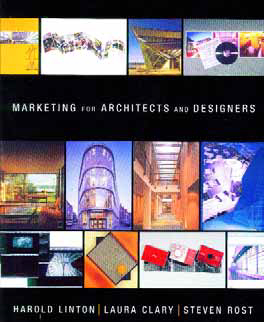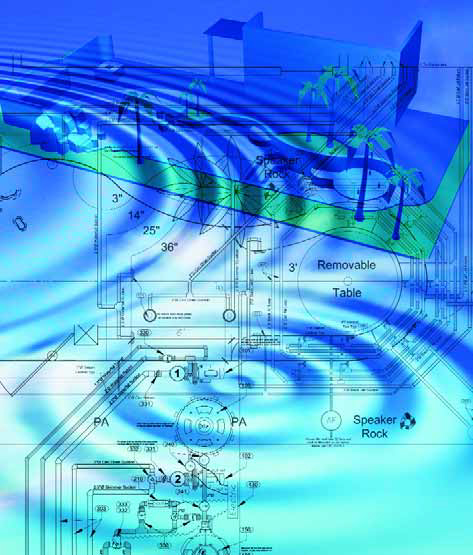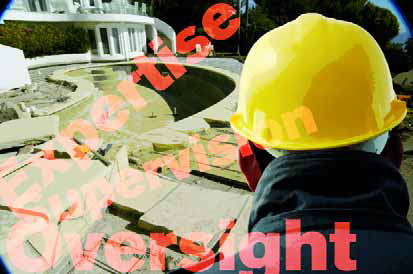communication
For years now, the power of teamwork and the communication it requires have been recurring, primary themes in the pages of WaterShapes. It's no secret that, more than ever before, the design, engineering and construction of custom watershapes of all sorts is a multi-disciplinary undertaking that involves
In this day and age, designers have a variety of ways to communicate their ideas to clients - hand drawings, models and computer imagery among them. We also know every client is unique and that each has his or her own way of absorbing information and processing concepts. Although there are some who never fully understand a designer's vision until a project's been built, most clients will accept one style of design presentation or another and in some way visualize what's happening. In the project we're currently engaged in with an historic Spanish Colonial Revival home in Orange County, Calif., however, we at Holdenwater, a design firm based in Fullerton, Calif., have had to use four
In this day and age, designers have a variety of ways to communicate their ideas to clients - hand drawings, models and computer imagery among them. We also know every client is unique and that each has his or her own way of absorbing information and processing concepts. Although there are some who never fully understand a designer's vision until a project's been built, most clients will accept one style of design presentation or another and in some way visualize what's happening. In the project we're currently engaged in with an historic Spanish Colonial Revival home in Orange County, Calif., however, we at Holdenwater, a design firm based in Fullerton, Calif., have had to use four
Who took the water out of watershapes? That may seem a ridiculous question, but it's also an obvious one when you see as many plans as I do - and by that I mean plans intended to indicate and initiate the watershaping parts of a wide variety of projects. Indeed, in my long experience in running an engineering-oriented firm, I've repeatedly been asked by designers to flesh out their watershape "ideas" (although in most cases vague inklings would probably be a more accurate way to describe them) and provide working drawings that reflect their "thinking." In my estimation, more than three-quarters of these plans lack any real indication of what the designers expect the water to do or how they want it to look. Instead, what I get is the typical overhead views with the ubiquitous "blue ghosts" or, in some cases, rudimentary sections of structures designed to contain water. It's left to me to probe and ask questions and determine what expectations they have about how the water is to appear and what it is to do. I've endured these common plan shortcomings for more years than I care to count, always wondering
Who took the water out of watershapes? That may seem a ridiculous question, but it's also an obvious one when you see as many plans as I do - and by that I mean plans intended to indicate and initiate the watershaping parts of a wide variety of projects. Indeed, in my long experience in running an engineering-oriented firm, I've repeatedly been asked by designers to flesh out their watershape "ideas" (although in most cases vague inklings would probably be a more accurate way to describe them) and provide working drawings that reflect their "thinking." In my estimation, more than three-quarters of these plans lack any real indication of what the designers expect the water to do or how they want it to look. Instead, what I get is the typical overhead views with the ubiquitous "blue ghosts" or, in some cases, rudimentary sections of structures designed to contain water. It's left to me to probe and ask questions and determine what expectations they have about how the water is to appear and what it is to do. I've endured these common plan shortcomings for more years than I care to count, always wondering
It only makes sense that designers should promote themselves in ways that reflect their abilities. When we look at the materials many watershapers use to market their services, however, it's obvious that everything from business cards to brochures and web sites has often been assembled without much attention being paid to how messages are conveyed in words, images or graphics. Recognizing these shortcomings in others prompted me to reflect on my own approach to marketing and promotion - which in turn led me to pick up a copy of Marketing for Architects and Designers by Harold Linton, Laura Clary and Steven Rost (W.W. Norton & Company, 2006). As the helpfully descriptive title indicates, this 150-page, beautifully illustrated text defines what designers need to know about
It only makes sense that designers should promote themselves in ways that reflect their abilities. When we look at the materials many watershapers use to market their services, however, it's obvious that everything from business cards to brochures and web sites has often been assembled without much attention being paid to how messages are conveyed in words, images or graphics. Recognizing these shortcomings in others prompted me to reflect on my own approach to marketing and promotion - which in turn led me to pick up a copy of Marketing for Architects and Designers by Harold Linton, Laura Clary and Steven Rost (W.W. Norton & Company, 2006). As the helpfully descriptive title indicates, this 150-page, beautifully illustrated text defines what designers need to know about
It's true for any subject that it's basically impossible to teach and learn about a topic unless there's a shared set of terms that everyone understands and can agree about what they mean. I've thought about that fact a lot in developing a course for university students about watershaping, or what I'm most often calling "water architecture" these days. With watershaping as a subject, that sounds simple enough. After all, we all know the meaning of "swimming pool," "fountain" and "pond." Or do we? I'm not so sure anymore. When I started breaking down our vocabulary for classroom use, I quickly recognized that the meanings of the words we use are anything but clear. Indeed, the more I dug into this seemingly simple phase of curriculum development, the murkier things became.The difficulty I ran into was this: Once I moved past the most rudimentary sets of terms and definitions and looked closely at the language we use to describe what we produce, it became painfully obvious to me that
It's true for any subject that it's basically impossible to teach and learn about a topic unless there's a shared set of terms that everyone understands and can agree about what they mean. I've thought about that fact a lot in developing a course for university students about watershaping, or what I'm most often calling "water architecture" these days. With watershaping as a subject, that sounds simple enough. After all, we all know the meaning of "swimming pool," "fountain" and "pond." Or do we? I'm not so sure anymore. When I started breaking down our vocabulary for classroom use, I quickly recognized that the meanings of the words we use are anything but clear. Indeed, the more I dug into this seemingly simple phase of curriculum development, the murkier things became.The difficulty I ran into was this: Once I moved past the most rudimentary sets of terms and definitions and looked closely at the language we use to describe what we produce, it became painfully obvious to me that
In the last several of these "Details," I've covered what happens in my projects before construction begins. Now we're ready to shift gears and look at what happens on site - the place where design and execution meet. Before we look at the way I build things, however, I want to take a hard look at common practices in the field. What I write here may seem harsh, but it's not intended that way: To establish a baseline for doing things in what I would term the right way, I need to point to practices in our industry - particularly the pool/spa sector - that


















